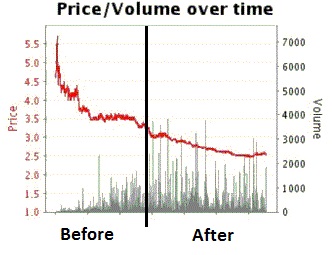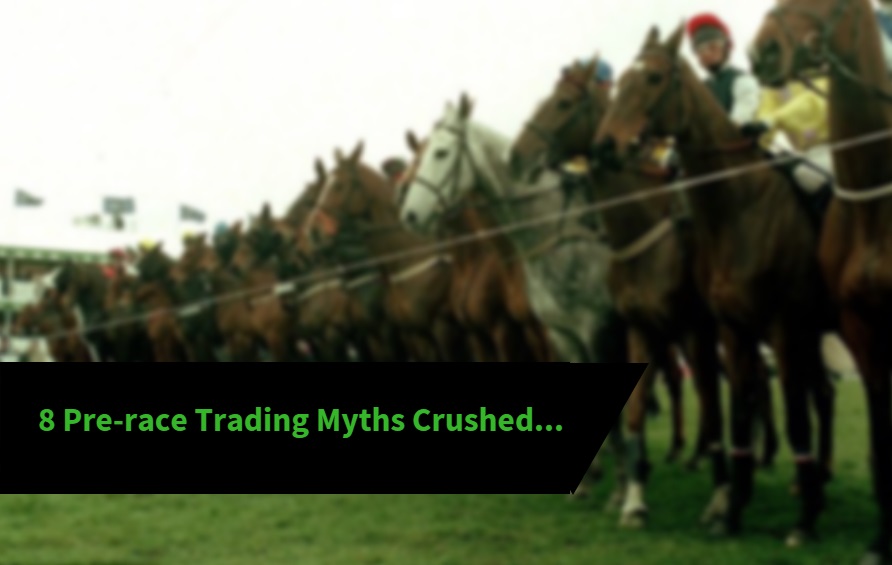When it comes to pre-race trading, there’s a lot of talk.
But how do you sift out the best quality information?
Most advice online appears to be given in good faith. However, it’s always useful to check your sources. Not all are honest about who they are, or what they’re doing.
In this post I’m going to quash 8 of the most common pre-race trading myths…
1: You Must Have a Big Trading Bank:
Don’t get me wrong, in some instances having a large trading bank is a benefit. However, generally speaking – it’s a disadvantage.
I say this is because whenever you increase the scale of an advantage you decrease the effectiveness, it’s that simple. Think about it; you soon realise that having a larger bank and placing larger trades increases the ability to have larger losses. It doesn’t necessarily increasing the chance of profitability either. Your edge had to cater for it.
Thinking otherwise is just flawed thinking. If you’ve seen the small bank challenge I recently completed then you will know Betfair trading offers you the opportunity to get larger percentage returns for your money than most other activities. The challenge mentioned increased the bank 48% over 3 days! That’s not typical for a larger bank though of course, covered in point #8.
In some ways it feels as though people use the bank excuse to alleviate their frustration with losing…
2: Manipulation Rules Pre-Race Markets:
I’m not going to deny it; within pre-race markets there’s a fair amount of manipulation. But as one door closes another opens.
It’s a case of finding the right opportunity. Video pack viewers will know exactly what I mean. The interesting thing with manipulation is the opportunity it can afford. Some instances allows the trader a very low risk, higher profitability opportunity. Even if it’s not every single race.
Manipulation certainly doesn’t control the entire market either. In fact, manipulation is just as exposed to market elements as any other trader. In some cases you can see the manipulative money getting stung. You may even want to take advantage of that…
3: Automation Stops Manual Traders:
This has to be the most ridiculous myth of all. Mainly because we are not at a stage where artificial intelligence can replicate all that a human does just yet.
For example, how would automation know that horse is about to be withdrawn from a race at the start?
Similarly, it wouldn’t realise that a football or tennis player has been injured mid-match. Sure, automation means that emotion and irrational responses within the automated trading strategy are reduced. Although it misses out on a whole load of opportunities too, particularly within the media coverage.

Also, automation cannot gauge how late an event may start. This is why markets behave slightly differently after post time, when pre-race trading.
4: Daytime Trading is Easier:
If you’ve pre-race traded both the daytime and evening markets, you may have noticed the difference in behaviour. But only a slight one. In most cases it’s like that saying about the difference between 6 and two 3’s.
Daytime racing produces more turnover and liquidity, although the evening racing gives us more gaps and sporadic behaviour. Depending on your trading style, you may find one feels quite different to the other. I certainly wouldn’t say one is particularly easier though. More a case of needing to adapt with the situation.
5: Graphs Won’t Help You Make Money:
A crazy statement. Graphs just like any other resource, provide us with information. Information of a past event, but market participants often routine and patterns to their behaviour.
Whilst each market is unique, having streaming graphs at your fingertips is certainly a benefit. If you’re unsure on how to read graphs then I suggest that you read this link.
I think it’s fair to say; the misunderstanding with graphs usually comes from those who are looking for a one size fits all strategy, something that does not exist.

6: You Just Need An Edge:
This is a common misconception from most people. Just like anything in life you need more than an idea…
If you think outside of trading, to things like Facebook and Google. I’m sure Mark Zuckerberg and Larry Page were not the first ones to come up with such ideas. They came up with them, and then executed better than everybody else. A large part of making money comes from execution, not just the idea or edge within any one particular situation. Functioning without an edge is foolish, but to think it is all you need is just daft.
7: Pre-Race Trading is the Hardest to Master:
I’ve lost count of how many times I’ve heard this, although it is factually incorrect.
Pause and give it some through for a second. Pre-race trading contains a huge amount of variables, which in turn makes it quite difficult. Don’t confuse difficult with impossible though. Having so many variables is actually a benefit too. It means there is more chance for the price to be inaccurate, and provide us traders with an opportunity to exploit.
Also, because of the amount of runners within a race, it makes things very hard to pin down the exact price any one horse should be. Let alone at every given moment. Is this not ideal when you compare it to something like tennis?
A betting market with less outcomes and variables has to be far more mechanical. I believe this is what makes it easier for price modellers and statisticians to pinpoint the correct price, and the way match points are structured.
To my mind, it’s obvious; inaccuracy and uncertainty means opportunity…

8: The Sky is the Limit:
Novice traders often think that once you find a profitable edge, and way of executing your trades, the sky is the limit. Again, untrue.
This isn’t going to be right because your profits can only be a reflection and in relation to, the overall situation.
For example, in horse racing each individual market is not as scalable as tennis or football. The plus side, of course, being the fact that there are more horse races each day. But when you take that again and compare it to something like greyhound racing, the opportunity is even smaller.
Why? Just take a look at how much is matched on the average greyhound market. If there is only £5,000 matched on the entire market, you’re going to have trouble making a couple of hundred pounds profit. But if that were a horse race with £500,000 matched – it’s likely to be very different.
Remember: Scalability and maximum potential comes directly from the amount of liquidity within any one market.
This concludes the eight pre-race trading myths that I regularly see online. If you can think of more and would like to join in the discussion I would encourage you to post in the comments below.
I’ll do my best to get back to you as quick as possible!
Related: Pre Race Trading Guide


3 thoughts on “8 Pre-race Trading Myths Crushed…”
What about ” always join the queue , never take the price ? “
That’s a good one, you mean to say it’s a myth that taking a price doesn’t work thought? Because that’s not necessarily true either 🙂
Hi , the myth of you should always join the back of the queue to save/gain a tick .Many vids and expert comments ( including yours – not a criticism btw ) encourage joining the queue and give examples of it costing you 1x tick every winning trade x 30 races etc etc. This is fine in theory if the money is being matched quickly at the price or is a very stable price eg Cheltenham. But generally , weekday stuff is more fluid and fast moving and very often you miss an entry for the sake of that1x tick and the price flies off costing many ticks. If swing trading surely its worth losing 1x tick to potentially win 10 ? I may be wrong of course and there will be a counter argument. Excellent stuff as always.